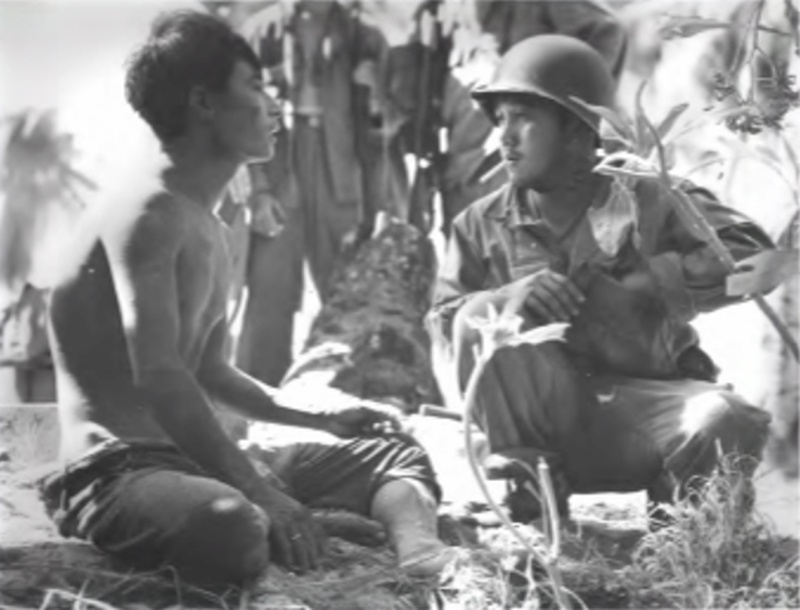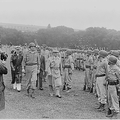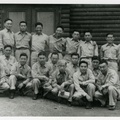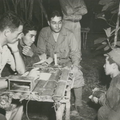Japanese Americans helped to win the War in Europe and the Asia Pacific and to prove their loyalty, which our nation had questioned. Also, timely tactical intelligence provided by Nisei linguists in the Pacific to infantry and marine commanders during combat saved countless American lives. Many combat medals were awarded to Nisei, including one Distinguished Service Cross for valor that was awarded to Bob Hoichi Kubo.
Kubo was born in Lahaina, Maui in 1919 and attended Japanese language school after his English school classes. He attended McKinley High School and the University of Hawaii in Honolulu. He was then drafted into the US Army in June 1941 and was among the 1,432 Nisei who was shipped on June 5, 1942 to Camp McCoy, WI for combat training and deployment. When the Military Intelligence Service (MIS) recruiters visited Camp McCoy to recruit Japanese linguists, Kubo and 59 others were selected for transfer to the MIS.
Following his Japanese language training in late September 1943, 20 linguists, including Kubo, arrived at JICPOA Annex (Joint Intelligence Center Pacific Ocean Areas), Honolulu. Kubo was assigned to the 27th Infantry Division, a New York national guard unit, which landed on Makin Atoll in the Gilbert Islands on November 20, 1942, followed by the invasion of Marshall Islands on February 1, 1944, and Eniwetok on February 19, 1944.
The 27th Infantry Division arrived in Saipan in early July 1944. A Japanese Navy civilian prisoner told Kubo the Japanese forces were planning to mount a gyokusai, “a battle of annihilation, or death with honor”, on July 7, by 4-6,000 Japanese. The Japanese forces struck as scheduled but the Americans were prepared, counter attacked, and defeated the gyokusai. After 24 days of ferocious combat, Saipan was declared secure on July 9, 1944.
The 165th Regiment, 27th Division remained behind in Saipan as part of a mop-up operation to clean up pockets where Japanese soldiers were hiding. Near a cliff, south of Marpi Point on July 26, 1944, two Okinawan civilians stood with their hands held high. They reported to Kubo that in a cave below Japanese soldiers were holding over 100 civilians. Approved by his unit commander, 1st Lt Peyre, Kubo stuffed his pockets with Army K rations, hid a .45 caliber pistol in his trousers, and at 10:00 AM, climbed down the rope 100 ft below and headed for the cave, alone and beyond any protective American support. Eight soldiers had their guns pointed at him. Their surprise to see a Japanese in US uniform soon turned to anger. They accused Kubo of being a spy, a traitor, and demanded to know why Nisei were fighting for the enemy. Kubo replied “I am an American, my forefathers fought for the Japanese 5th and 6th Divisions in the Russo-Japanese War, I am here to take out the non combatants and ask for your surrender.”
Kubo was invited to enter the cave, where the soldiers set their guns aside but kept their hand grenades beside them. The Japanese were preparing their meal so Kubo shared his K rations with them. The soldiers continued to question Kubo why he was fighting for the America and not Japan. Kubo said “you soldiers were born in Japan, are sons of Japanese parents, so you are fighting for Japan. I was born in America, also son of Japanese parents, and I fight for America”.
After speaking for two hours and not being able to convince the soldiers, Kubo recited a palindrome, taught in Japanese schools, by Taira no Shigemori in 1197 when his father requested him to defeat the emperor. Taira told his father: “If I am loyal to my father, I cannot serve the Emperor; if I am loyal to the Emperor, I cannot serve my father.” Upon saying this, Kubo said, “America is my country." The soldiers said they now understood, stood at attention, bowed, and apologized for questioning his honor. They asked Kubo to leave, If their decision were favorable the civilians will appear at the top of the cliff by 2:00 PM. If they did not, the Americans’ standard procedure was to dynamite and seal the cave.
The first hostage appeared at the top of the cliff at the appointed hour, followed by 121 other civilians and the 8 soldiers, minus their weapons. Kubo was awarded the DSC. Some years later, Kubo observed that while he was pleased to receive the DSC he was happy to see the 8 soldiers in the group. Also, Kubo said he was pleased to learn that some Japanese civilians and soldiers signed affidavits which supported the granting of the DSC to Kubo.
After Saipan, Kubo’s 27th Division’s next major engagement was Okinawa. Following his discharge in 1945, Kubo went to work for Hunt Foods as sales manager for the Hawaiian Islands. In 1955, Kubo moved to San Jose, CA where he and his brothers opened the Aloha Super Market and operated it until 1980.
Kubo, reflecting the attitude of Nisei combatants in Europe and the Pacific, felt deeply about America’s values and defended it with his life. [Larry Kubo, son of Hoichi, contributed to this report. ]
*This article was originally published in the Fall 2017 issue of the Japanese American Veterans Association’s newsletter The Advocate.
© 2017 JAVA Research Team, Japanese American Veterans Association







